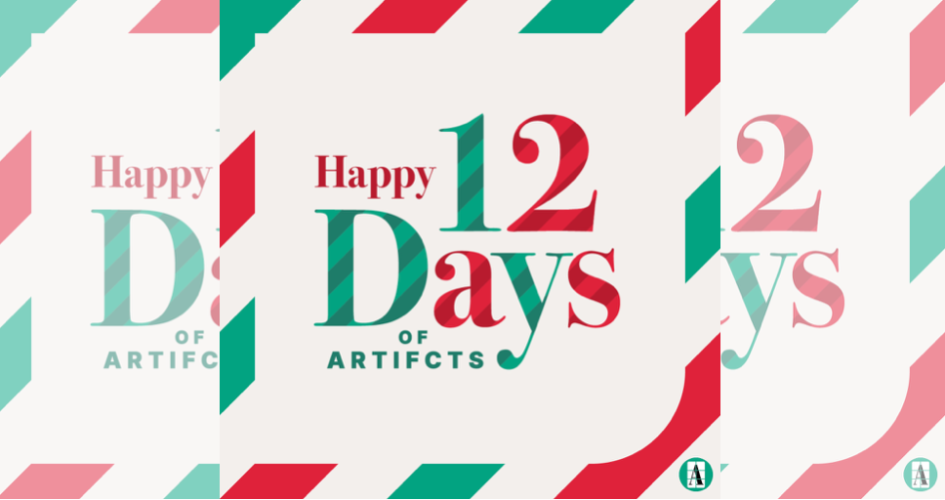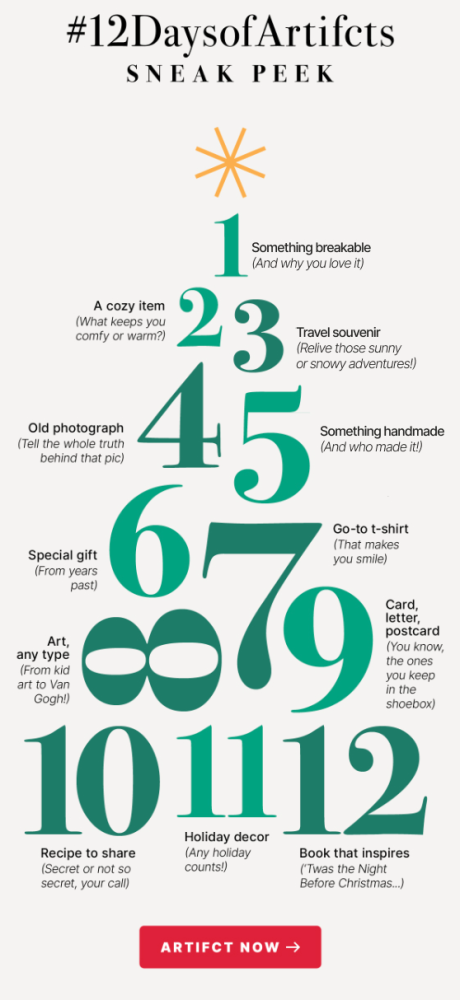Reading time: 7 minutes
You may be surprised, but in the world of tough ‘stuff’ to sort through, declutter, and organize, for many of us our closets top the list. Call it what you want, but we’ve learned that along with the many stories and memories those closets hold, closets can store a lot of trauma inside, too.
Think about the bedroom closet alone. We pack in the past lives we lived in those clothes, past versions of ourselves that fit into those clothes, and cherished pieces and memento boxes that tie us to places or times we want to remember. Maybe we even stash and store the same for loved ones who have passed or kiddos we’ve raised.
As you surely have guessed by now, in this edition of ARTIcles by Artifcts, we’re closing out our “Every Room Has a Story” series with a focus on your closets.
Catch up on past editions in the series: Living Room | Kids’ Rooms | Bathroom | Kitchen
A Walk Back in Time: The Red Coat
More than 50 years ago, a young college student in Chicago met the man she was going to marry through mutual friends, as is so often the case. She had one of those personalities that exuded light and energy and attracted people to her. And if that weren’t enough, she boldly wore a brilliant red, full-length, heavy wool coat to counter the long and sometimes gray and dreary Chicago winters. Hard to miss!

What's your "red coat," that item in your closet you just can't part with even if you'll never wear it again?
Fast forward to the present day.
The woman’s husband and one of her grown daughters are in the former master bedroom on the second story of the family home. Even though the new master bedroom on the first floor has been in use for at least 10 years and boasts a beautiful custom closet and dressing area, the old walk-in master closet is still brimming with clothing, old suitcases, and more.
Hemming and hawing over how to tackle this ‘stuff’ in preparation for a future downsizing move, the woman’s husband spots the red coat. “Oh, you have to take this to your mother.”
With a quizzical look, the daughter grabs the coat and heads downstairs to her mother.
“My red coat! Where did you find it?” the mom says, as though she just misplaced it yesterday, when in fact the daughter had never in her 40+ years of life seen the coat. And with good reason, too. The coat, clearly of high quality, had stains and moth holes that suggest it should be retired.
“You know, I wore that coat when I was in college. Your dad could spot me across campus,” said the mother. “It was fun to be the ‘gal in the red coat.’”
You see, that coat was a part of a moment in time when their love story was unfolding. It was as fresh in the woman’s mind as anything she’d worn since. She had no interest in downsizing this coat, even after decades of disuse. Despite its bulk and condition, it would be making the future move.
Stories & Your Closet
If you want to embrace feng sui concepts of harmony and balance, closets are an intuitive space to start, partly because closets are so prone to chaos. Closets often come with doors, too, allowing us to ignore the chaos for another day.
Sorting like with like, using matching sets of hangers and storage boxes, arranging shoes in the same front facing fashion, and the like, are the simplest means to diminish closet chaos. But if you truly want to declutter, never mind downsize, recognizing and honoring the stories within, we’d argue, is a critical second.
1. The ‘Why’ of the Clothing We Keep.
We’re talking specifically about clothing you’ll never wear again. It’s one of our spring-cleaning themes and top targets for decluttering. You know it’s there, even if hidden, the clothing you should recycle or donate. We’re looking for:
-
-
- Holes, tears, stains
- Faded fashions
- Ill-fitting pieces
- New, with tags, because you had a vision you never brought to fruition, or it simply got buried
- Single-purpose pieces (hello, bridesmaids dresses, costumes, and event and corporate swag)
If you’re wrestling with the sentimental nature of a piece, Artifct that. You’ll feel better.
Both of our cofounders have Artifcted old suits they wore in their government days. There’s a lot of memories in those suits and feelings of pride and accomplishment. You may know the feeling tied to a key garment and moment in your own life. Artifct that and then donate that to Dress for Success or a similar charity.
Hot tip: If it’s a bridesmaid dress you’re thinking of donating, ask the bride before you donate, in case she harbors dreams of a vow renewal one day. We’re happy to save you the potential regret if you didn’t ask!
2. The ‘Why’ of Memento Boxes.
Now the existence and content of some of these keepsake boxes are open secrets, others not so much. But these keepsake boxes and memory boxes, no matter how cute, stylish or feng sui, are vulnerable to fire and flood as well as creatures that could find them munchable. In addition, the details behind what’s inside will easily fade from memory and more rapidly than you’d like to imagine.
True story: One of our co-founder's daughters recently created a memory box for school. She promises to Artifct first whatever goes into it. Will she? Time will tell. She already has more than 100 Artifcts, so there’s hope.
If you care about what’s in your memento boxes, we implore you to Artifct that. And talk through the contents with them. Have a seat. Share, more than once. Let them know you better. We will never tell you these types of boxes, in moderation, have to go. In fact, we believe everyone deserves a purple bin, yours might just be another color or style.
3. The Why of the Bulky Closet “Clutter.”
Yes, clutter lives in closets, too. We STASH so much in those closets. Take a look and ask about the why behind your stashes.
A recent closet we were in had stashes of:
-
-
- Gifts to give “someday,”
- Unused frames in want of art or photos,
- Old, unused medical supplies,
- Brown paper bags of old tax documents and banking records, and
- A box of family heirlooms from a loved one who had passed away six years prior.
The why of stashes often comes down to some form or procrastination. As Matt Paxton likes to say, “Procrastination kills memories.” Procrastination also creates chaos and kills the good intentions in the keeping.
-
-
- Organize what you want to keep and label it, if that will help you remember it’s there so you can put it to good use. The reason professional organizers love clear bins is to keep the items visible. But if labels do the trick—or a combination of both—go for it! If you are helping someone with dementia to declutter and organize, clear bins and photos have other purposes. Check out this ARTIcles story for insights and tips!
- Artifct items from loved ones and share those Artifcted stories so others can enjoy. Plus, if you don’t want to keep it all, your Artifcts become the easy means to ask if others would like to keep the items. Win-win!
- Donate unused—and in some cases lightly used—medical supplies through Goodwill or other similar charitable organizations in your community.
- If those old documents are more than seven years old, you’ll generally be okay to shred them yourself or at a community shred event. If in doubt, ask your financial advisor. But do not hang onto these where they can do you no good and only create vulnerability if someone were to use the information they contain to access resources they should not.
Procrastination kills memories. - Matt Paxton, TV host, author, public speaker
A storage bin for documents organized with labeled file folders can be a better than nothing option, but is nearly as problematic as a brown paper bag. A digital vault, like Trustworthy, can organize important documents via files and images you upload in no time and ensure vital information is accessible to you, your loved ones, and any tax, legal, or other advisors you employ. Bonus: Digital resources can be accessed anytime, from anywhere and you can even receive smart notifications when renewals and updates are required.
4. Special Closet Clutter: Kid Stuff.
We’re talking about reducing kid clutter we’ve found in closets, which admittedly feels a bit like touching the third rail. But hear us out! Do you really need to wardrobe a future generation? How much of it will breakdown or decay before it can ever be used again? And, perhaps most importantly, do you remember why it’s so special? No? Great, out and onward it goes. Yes? You know what we’re going to say: Artifct That.

Here’s a great example from our cofounder Ellen. She did keep a couple dresses that belonged to her daughter as a baby and a toddler. Notice we said a couple. But she also Artifcted them with pics of her daughter wearing the dresses to make it oh-so-easy to remember and share the why behind the dresses. CLICK THE IMAGE to view the Artifct.
While sentiment and frugal tendencies can be at play, sometimes you find people are holding onto stuff that their GROWN adults have ASKED them to keep, because they don’t have the space or do not want to take the time or pay the expense to ship it to their homes. Hard no. If you are ready to lighten the load in your home, give your grown adult children a deadline to claim the items. Yes, “adulting” can be hard, but enabling grown adult children to behave, well, like children, doesn’t generally end well. If you can relate, you might want to read or re-read this inspiring guest ARTIcles story from a dad who shared the tough love he showed his adult children during his downsizing experience.
Many of us struggle to bring our habits, best intentions, or even creative brains into play to help us get the job "decluttering" job done. For others, the stories behind the stuff get in our way. But keep in mind as you go room by room that like any muscle, decluttering requires practice. And Articting is here to support you along the way. Object by object as you Artifct you can reflect on what it is, why you have it, and make a decision on what will happen to that object in the future.
###
© 2024 Artifcts, Inc. All Rights Reserved.















 The first four days of our 12 Days of Artifcts challenge. Objects with stories, your stories!
The first four days of our 12 Days of Artifcts challenge. Objects with stories, your stories!



